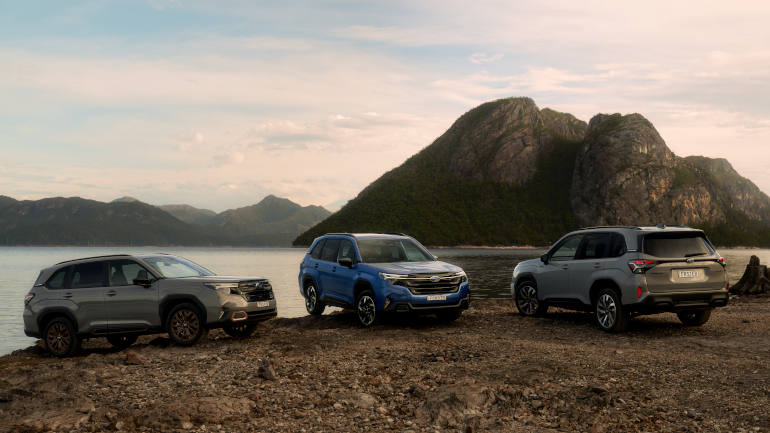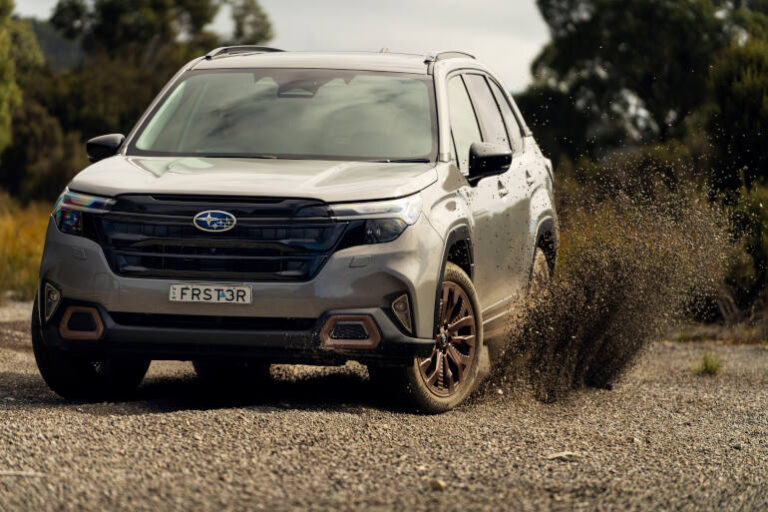Subaru has officially lifted the lid on the sixth-generation Subaru Forester, with order books now open and first deliveries expected from July 2025. While the entire range boasts meaningful upgrades in technology, safety and design, it’s the new strong hybrid models that will attract the attention of Fleet Managers looking for a dependable, all-weather-capable medium SUV with a lower environmental footprint.
Three Hybrid Variants – One Purpose
The hybrid Forester range consists of three variants:
- Forester AWD Hybrid – $46,490
- Forester AWD Hybrid Sport – $54,990
- Forester AWD Hybrid Touring – $55,990
Each model is powered by Subaru’s next-generation strong hybrid e-Boxer powertrain, which combines a 2.5-litre direct-injection Boxer engine with a 90kW electric motor. The result is a total system output of 145kW – a substantial 31.8% increase over the outgoing mild hybrid setup.
While it’s not the lowest fuel consumption figure in the hybrid SUV class, the Forester Hybrid achieves a respectable 6.2L/100km combined and 6.4L/100km in urban driving. The key advantage? A larger 63-litre fuel tank – up from 48 litres in the previous model – which contributes to a claimed range of over 1,000 kilometres on a single tank. For fleet operators managing remote area vehicles or long-range regional transport, this alone could justify a closer look.

Hybrid vs. RAV4: A Fair Comparison?
Some may be quick to point out that the Forester Hybrid uses more fuel than the market-leading Toyota RAV4 Hybrid (which is rated at just 4.7L/100km in 2WD form). However, that comparison is not apples-to-apples. The RAV4’s most popular fleet variant is 2WD, while every Forester – hybrid or petrol – comes standard with Subaru’s symmetrical all-wheel drive (AWD) system.
This always-on AWD setup isn’t just about capability on unsealed roads – it’s part of the Subaru DNA. It provides confident handling in wet weather, greater cornering stability, and proactive traction control. The AWD system is mechanically linked, meaning torque is delivered to all four wheels at all times, unlike many competing systems that react only after traction is lost.
For many fleet managers, especially those working across regional areas or in sectors like utilities, local government, health or telecommunications, that level of control is non-negotiable.
Designed for Fleets That Go Beyond the Urban Grid
Every Forester Hybrid features 220mm of ground clearance, dual-mode X-Mode for snow/dirt and deep snow/mud conditions, and Subaru’s renowned symmetrical AWD. Combined with the instant torque of the electric motor, these SUVs are genuinely equipped to handle conditions well beyond city limits.
Subaru has also reengineered the interior to reduce noise and vibration, with a more comfortable seating design and better insulation. Every hybrid variant comes standard with an 11.6-inch touchscreen, wireless Apple CarPlay and Android Auto, Qi wireless charging, and an extensive suite of safety features including:
- Subaru’s EyeSight Driver Assist System with emergency driving stop system
- Driver Monitoring System with distraction and drowsiness detection
- Panoramic 360° View Monitor
- Nine airbags, including driver’s knee and far side airbags
The hybrid sport and touring grades add further touches such as 19-inch wheels, Harman Kardon audio, water-repellent seating (Sport), and leather and Ultrasuede trim (Touring). The Hybrid Touring also benefits from ventilated front seats and a premium digital instrument cluster.
Towing and Practicality
The Forester Hybrid maintains practicality for light towing needs, with a 1,200kg braked towing capacity and 120kg tow ball download limit. While this is lower than the petrol Forester’s 1,800kg limit, it remains suitable for small trailers, bikes, or light plant equipment.
Notably, due to the battery placement, hybrid variants come with a puncture repair kit instead of a spare wheel. However, Subaru has addressed fleet concerns by offering a dealer-fitted accessory package that includes a towbar-mounted spare wheel carrier and full-size spare – ensuring remote area compatibility.
Service Intervals and Warranty
The Forester Hybrid is backed by a five-year/unlimited kilometre warranty, with the hybrid battery covered for eight years or 160,000km. Service intervals are 15,000km or 12 months, whichever comes first – a practical match for fleet operations.
Why the Forester Hybrid Should Be on Fleet Managers’ Radar
While it may not lead on fuel economy stats, the Subaru Forester Hybrid stands out where it matters most to fleet managers – long-distance capability, full-time AWD safety, low driver fatigue, and outstanding build quality.
Its fuel tank capacity and hybrid efficiency allow for rare refuelling, while the retained value and Subaru brand reputation make it a strong total cost of ownership (TCO) proposition. Add in the latest safety tech and a focus on off-road confidence, and you get a hybrid SUV that’s tailored to the Australian fleet landscape – not just urban couriers.
Fleet buyers evaluating medium SUVs for real-world versatility should be taking a serious look at this new-generation Forester. It may not be the flashiest on the spreadsheet, but when it comes to keeping drivers safe and productive, rain or shine, road or track – it makes a compelling case.







